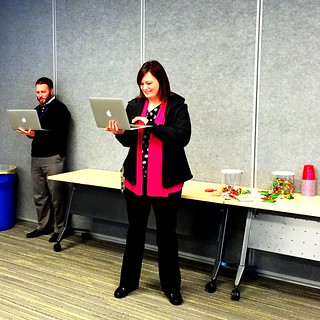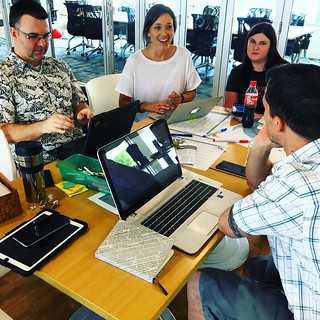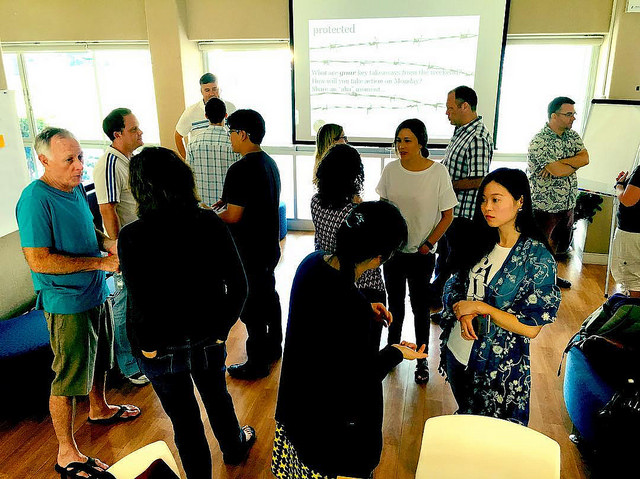Over the past few months I’ve been facilitating a lot of professional learning, in a lot of different environments – from international schools (my comfort zone), to private schools in several different countries, to public schools in the US (which used to be way out of my comfort zone, but not so much anymore);  and with all different stakeholder groups including teachers, administrators and parents. It’s been tons of fun, and lots of professional growth for me (and hopefully the people I’m working with)!
and with all different stakeholder groups including teachers, administrators and parents. It’s been tons of fun, and lots of professional growth for me (and hopefully the people I’m working with)!
One of the elements I’m trying really hard to focus on is ensuring that the workshop format allows participants to develop their own understandings through active participation in hands on activities, rather than talking, hearing or reading about an idea.
Usually I find this easy for tool exploration, developing curriculum, understanding terminology or pedagogical frameworks, but sometimes a little bit more tricky for big concepts. Often in those cases, I might tend to lean towards reading a text or watching a video and following a discussion protocol.
Two Layered Learning Experiences
So I’m super excited that the work we, at Eduro Learning, have been doing – with Marysville School District in Washington State and with our Eduro Learning Institutes, along with some really interesting training I’ve been doing with Apple Singapore – have inspired two new, similar formats, that really enable participants to experience big ideas and concepts as they are learning about them!
These two formats are both layered activities, where each one builds on the next. Each one happens to have 3 layers, so it reminds me of TV show challenges, like Top Chef, where they prepare one menu item multiple ways.
Learning From Texts: 3 Ways
I know I said this was not about reading, so the title of this one sounds a little off, but I promise it’s not just about reading!  For our work in Marysville, teachers are learning how to use Google Apps for Education, so we are actively using a variety of tools each session within the context of our work so they can make connections to their own classroom – in addition to focused and purposeful hands on tool exploration and guidance.
For our work in Marysville, teachers are learning how to use Google Apps for Education, so we are actively using a variety of tools each session within the context of our work so they can make connections to their own classroom – in addition to focused and purposeful hands on tool exploration and guidance.
Every time we do a training, we make sure to highlight a pedagogical concept that may be new to the teachers or admin. We always do lots of activities that highlight the key themes, but we usually also like to have a text for teachers to dive a little bit deeper.
Often the texts are longer, because they’re research-based and intended to be a focus for the day. Of course we don’t want teachers to sit and read a long article in the room with us, and we know it’s unlikely that they’re going to read it before the session, but we also know teachers have students do lots of reading too, so we want to model effective ways to do that with students, while taking advantage of the technology tools they have access to.
This first layer of this activity was inspired by Jeff, and then in conversation with me and Chrissy, spun off into it’s current three-layer version (I love teamwork!).
So, here’s what we do:
First Layer: Reading Alone, Together
 Participants are given the first selection of a longer text to read copied and pasted into a Google Doc (with proper citation, of course). The Google Doc is view only and participants are asked to make one copy for each table group (and then share with the rest of the table).
Participants are given the first selection of a longer text to read copied and pasted into a Google Doc (with proper citation, of course). The Google Doc is view only and participants are asked to make one copy for each table group (and then share with the rest of the table).
As they read, they can highlight and comment on sections of the article that resonate with them. Within the set amount of time, they read and comment and then, as a whole group, we discuss the key themes of the article.
Second Layer: Reading Alone, Together, Structured
Just like the first layer, we read the next section of the text from a Google Doc. This time, the entire group (not table groups, the whole class) collaborates on one document where everyone is given commenting rights. Because this is a much larger group, and people have often commented that having other comments pop up while they’re reading is distracting (from the first session), this time we follow a time structure.
 The first 10 minutes are quiet reading only, the next five are commenting, and the final five are replying to comments. If teachers prefer to comment as they read, we recommend they make a copy of the document, comment there and then transfer over when it’s commenting time. When the twenty minutes are complete, the whole group discusses the text.
The first 10 minutes are quiet reading only, the next five are commenting, and the final five are replying to comments. If teachers prefer to comment as they read, we recommend they make a copy of the document, comment there and then transfer over when it’s commenting time. When the twenty minutes are complete, the whole group discusses the text.
Third Layer: Reading Alone, Together, with Protocol
For the final layer, we have participants follow the second layer, but instead of having a general discussion at the end, we ask them to follow a text protocol. We usually use one like The Final Word or Three Levels of Text.
This combo of Reading Alone, Together with Google Docs plus a text-based protocol gives teachers an easy comparison between unstructured discussion and a focused and purposeful conversation. This doesn’t mean that one is better than another, but it’s good to know you have options!
Why these 3 layers?
The purpose of each layer is to help teachers understand:
- how they can use essentially the same tool in a multiple ways.
- that each way may appeal to a different group of students – and they can all be easily facilitated in one classroom.
- that we can be purposeful with our use of texts within a lesson period.
Some great conversations that came out of this process were:
- the potential use of Google docs as a collaborative, dynamic textbook for students. My husband, Alex, does this really well – he’ll put a shared text into a Google Doc and as the students are reading and learning new ideas, they will link words to definitions, videos, images so that they can get a deeper understanding of the text through their own research. This is also very powerful for English Language Learners who may not know the vocabulary, but can click on a link to watch a video selected by another student.
- the power of commenting, and making time for commenting in written form. Often we’ll ask students to comment on each others’s work, but don’t always provide time for doing so. The structured layer provides specific time (and format) for reading through comments and starting a digital conversation, which can then springboard into a face-to-face discussion.
Reflecting on Learning: 3 Ways
 After using this reading from text process a few times in Marysville and seeing how fantastic it was to compare different learning strategies within the same context, I was inspired to try it again at our Eduro Learning Institute last weekend at NIST, this time in collaboration with my superstar NIST colleague, Tosca Killoran. For this workshop, I wanted to have a “three ways” activity with the reflection process. This was also inspired by our work with Marysville, because the three activities are all part of our regular training, we just haven’t combined them like this before (I’m remixing!).
After using this reading from text process a few times in Marysville and seeing how fantastic it was to compare different learning strategies within the same context, I was inspired to try it again at our Eduro Learning Institute last weekend at NIST, this time in collaboration with my superstar NIST colleague, Tosca Killoran. For this workshop, I wanted to have a “three ways” activity with the reflection process. This was also inspired by our work with Marysville, because the three activities are all part of our regular training, we just haven’t combined them like this before (I’m remixing!).
This weekend workshop, called Create, Capture, Curate: Sharing Student Learning Through Technology, was all about empowering student creators. Tosca and I had teachers use a variety of tools to create their own documentation of learning, and we really highlighted the value of doing all of this publicly. After the first full day, we realized that we hadn’t quite addressed the value and purpose of sharing in a more private setting, and we wanted to make sure that the participants had an active way to experience the difference, rather than just talking about it.
They were asked to comment on any of the following prompts for each of the layers:
- What are your key takeaways from the weekend?
- How will you take action on Monday?
- Share an “aha” moment…
Here’s what we did:
First Layer: Reflect on Learning: Private
 To help consolidate their own thinking, we asked teachers to create a private video journal reflection (“talking head” style). This would not be shared with anyone else, unless they chose to do so (and a few did!) and shouldn’t take longer than 5 minutes total. They could pre-write if that would be helpful, and use any tool at their disposal.
To help consolidate their own thinking, we asked teachers to create a private video journal reflection (“talking head” style). This would not be shared with anyone else, unless they chose to do so (and a few did!) and shouldn’t take longer than 5 minutes total. They could pre-write if that would be helpful, and use any tool at their disposal.
Second Layer: Reflect on Learning: Protected
Sometimes we forget that there is a middle ground between public and private. We can have conversations with an audience that we define and control – even in online spaces. So this round was an opportunity to share the thinking from the journal reflection with other participants.
We used an elevator pitch process where participants got into pairs (an elevator) and each person has 30 seconds to share a response to any one of the same three prompts. They had time to share with three partners (3 elevators).
Third Layer: Reflect on Learning: Public
Finally, after sharing both privately and in small groups, participants were asked to share their thoughts on any one of the prompts in a public space with the hashtag #eduroccc. Although a few chose to share their first private video, most people refined their thinking to fit within the context of this new audience.
Why these 3 layers?
The purpose of each layer was to help teachers understand:
- there is value in different types of sharing, and it can be useful at different times.
- some people feel comfortable sharing with a wider audience, and some don’t, we can accommodate all types of learners, even using the same tools.
- depending on our own personal readiness, or the readiness of our school community, we can all use the new learning strategies we learned at the workshop – just by managing the sharing level.
Some great conversations that came out of this process were:
 Completing the private sharing first helps participants consolidate their own thinking before being influenced by others. If you want to get an understanding of what students are thinking, you can ask them to share the journal with you (in advance) and that would give you an insight into their thought process at the moment. If you would like students to generate ideas (almost in a collaborative brainstorming process) then you might want to flip the second and first layer.
Completing the private sharing first helps participants consolidate their own thinking before being influenced by others. If you want to get an understanding of what students are thinking, you can ask them to share the journal with you (in advance) and that would give you an insight into their thought process at the moment. If you would like students to generate ideas (almost in a collaborative brainstorming process) then you might want to flip the second and first layer.- Having the ability to experience reflecting three ways really highlights the importance of selecting what you share. Because everyone knew they would share three different ways in advance, they could choose what they wanted to share for each segment of the activity.
- Sharing three ways only took a total of 20 minutes. It was interactive and fun, and not only helped teachers reflect on their learning, but also get new ideas and inspiration in that last 20 minutes of the day.
Final Thoughts
Every time I run a session, I learn something new (which of course makes me want to run that session all over again so I can apply my new learning and make it even better)! I love the way the work that we’re doing with Marysville and our Eduro Learning events can quickly and easily tie in with my existing comfort zone of working with international schools. What works in one context, often works just as well in another – at least when we’re all talking about teaching and learning!
What strategies have you found to be particularly effective in helping teachers develop their own understandings through experiences? Could you use either of these with your teachers or students?
Images:
- Elevator Pitch Reflections by Kim Cofino, Creative Commons Licensed on Flickr
- Superstar teachers at #eduroccc by Kim Cofino, Creative Commons Licensed on Flickr
- rainbow layer cake by Crazy House Capers, Creative Commons Licensed on Flickr
- Reading by Mark Probst, Creative Commons Licensed on Flickr
- Don’t Walk – Red Man by Dominic Alves, Creative Commons Licensed on Flickr
- Recording video journal reflections with Marysville teachers, by Kim Cofino, Creative Commons Licensed on Flickr
- Epic smoothie in Vitamix blender by Kristoffer Trolle, Creative Commons Licensed on Flickr
- Awesome final projects from #eduroccc by Kim Cofino, Creative Commons Licensed on Flickr






Thanks for this, Kim. Several times throughout the post, I found myself relating to what you said. I am now doing similar work facilitating professional learning in public schools in the States, which started WAY out of my comfort zone (the international market). We use many of those same strategies and protocols. I find that strong facilitation is essential–leading participants to construct their own understanding. I love starting off with an inclusion activity (I get great ideas from Adaptive Schools resources) to get everyone’s voiceand brain in the room. Active learning is key. People need to be doing, discussing, debating.
One of the most successful sessions I’ve led was when we used the Tuning Protocol by the National School of Reform. Super powerful for educators! Everyone walks away with something.
Thanks Emily!
I love the NSR stuff too – those protocols are so helpful. I will check out the Adaptive Schools resources too, I know of them from Cognitive Coaching, but I don’t think I’ve actually used their resources.
Thanks for sharing, Kim! Always great to get new ideas for creating effective learning opportunities for our staff!
8 )
Kim,
Once again you have my brain spinning on how to apply this both in the classroom and with PD sessions. Besides giving ways for people to process individually and then structured within a group and for written and spoken processing I also wonder about processing time. Have you found some people not quite ready within the given format and on the flip side, others that feel it is taking too long? It is one more difference in learners and another layer I am considering as I keep the post up to re-read a couple of times.